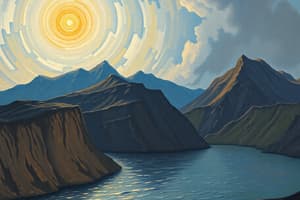Podcast
Questions and Answers
What is the outermost layer of Earth called?
What is the outermost layer of Earth called?
lithosphere
What are the two types of crust mentioned?
What are the two types of crust mentioned?
- Mantle crust
- Oceanic crust (correct)
- Lithospheric crust
- Continental crust (correct)
Oceanic crust is denser than continental crust.
Oceanic crust is denser than continental crust.
True (A)
Who hypothesized the theory of continental drift?
Who hypothesized the theory of continental drift?
What evidence did Wegener find to support his theory?
What evidence did Wegener find to support his theory?
What fossil evidence did Wegener find on both the eastern coast of South America and the western coast of South Africa?
What fossil evidence did Wegener find on both the eastern coast of South America and the western coast of South Africa?
The layer of molten rock found between the crust and core is called the ______.
The layer of molten rock found between the crust and core is called the ______.
Which two continents had matching fossil evidence of the land reptile Lystrosaurus?
Which two continents had matching fossil evidence of the land reptile Lystrosaurus?
Flashcards are hidden until you start studying
Study Notes
Earth’s Layers and Tectonic Plates
- Earth consists of layers: crust (top), mantle (thick molten rock), and core (center).
- The lithosphere is the rigid outermost layer, comprising the crust and upper mantle.
- Tectonic plates, large pieces of the lithosphere, are categorized into oceanic and continental crust.
- Oceanic crust is denser than continental crust, contributing to the elevation of continents above the ocean floor.
- Some continental plates can be submerged, while some oceanic plates, like Iceland, are above sea level.
Major Tectonic Plates
- Major tectonic plates include:
- African Plate
- Antarctic Plate
- Eurasian Plate
- Indian Plate
- Australian Plate
- North American Plate
- South American Plate
- Pacific Plate
- Plate boundaries are where geological activity occurs, causing earthquakes, mountain formation, and volcanic activity.
Historical Perspective on Continental Movement
- Observations reveal continents fitting together like a jigsaw puzzle, suggesting a historical connection.
- The theory of Continental Drift was proposed by German scientist Alfred Wegener in the early 20th century.
Evidence for Continental Drift
- Wegener gathered evidence showing geological formations on connected coastlines aligning, such as mountain ranges.
- Glacial sediment deposits correspond with matching coastlines, indicating past connections between continents.
Fossil Evidence
- Fossils of the freshwater reptile Mesosaurus were discovered on both the eastern coast of South America and western South Africa, suggesting proximity.
- Fossils of Lystrosaurus, a land reptile, were found across eastern Africa, central India, and Antarctica, which could not have evolved separately.
- Wegener concluded that continents must have been joined at some point to explain the distribution of these fossils.
Studying That Suits You
Use AI to generate personalized quizzes and flashcards to suit your learning preferences.




